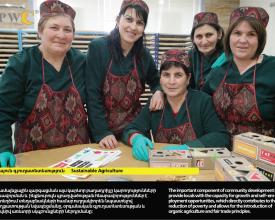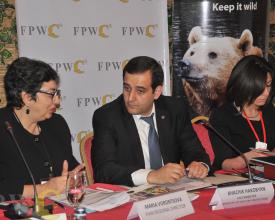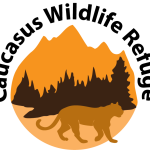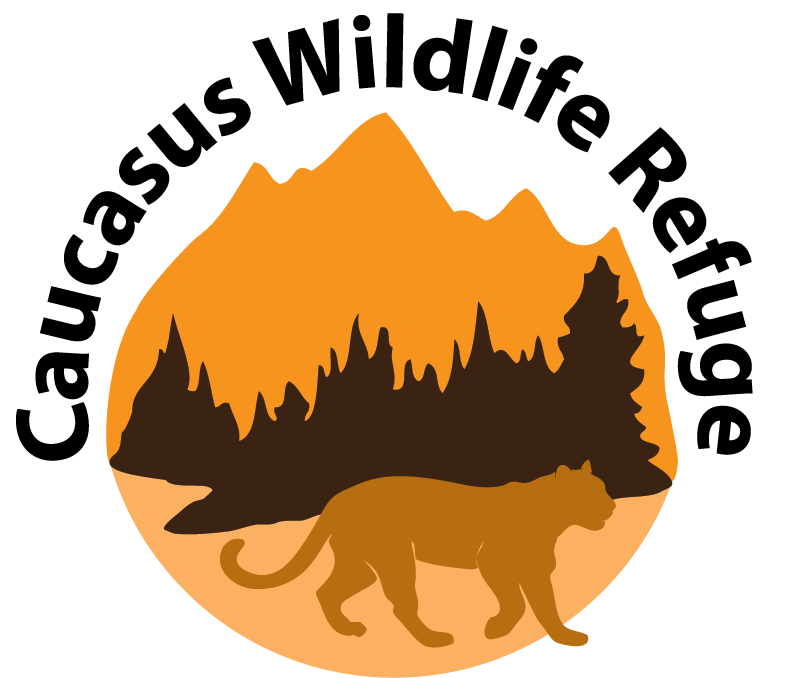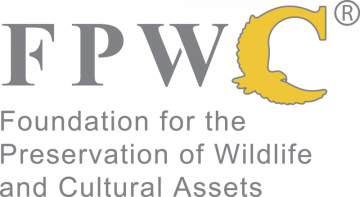
Refuge de la faune du Caucase : Un pionnier de la conservation privée en Arménie
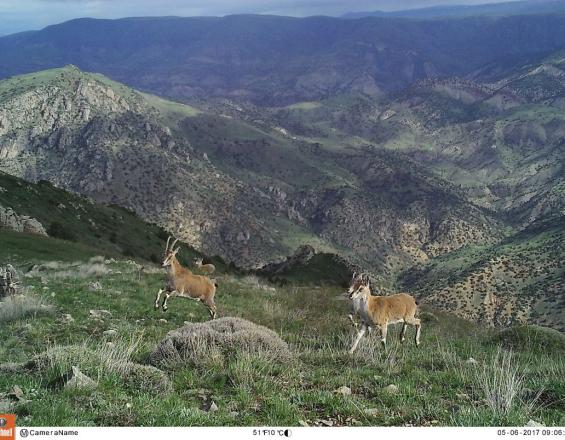
Le Caucasus Wildlife Refuge (CWR) est une zone protégée privée gérée par le FPWC. Passé de 400 à 20000 hectares depuis 2010, le refuge s'étend le long de la frontière de la réserve naturelle d'État de la forêt de Khosrov (catégorie Ia de l'UICN). L'objectif global du CWR est de contribuer à une protection efficace de la biodiversité en Arménie en améliorant les mesures de conservation dans les zones tampons et les couloirs de migration de la faune sauvage de la réserve qui étaient auparavant gérés de manière non durable. Pour ce faire, le développement durable des communautés, la conservation et le changement de comportement sont interconnectés.
Le FPWC maintient une station de gardes forestiers permanente dans la région (6 gardes sont employés par la communauté), qui est suffisamment équipée pour protéger le territoire contre tout impact humain négatif. Les gardes patrouillent les 8 000 hectares 24 heures sur 24, 7 jours sur 7, empêchant toute activité illégale dans la zone et surveillant les animaux en appliquant les technologies les plus récentes. CWR est le seul projet de ce type dans tout le Caucase du Sud.
Contexte
Défis à relever
L'état actuel des pratiques de conservation en Arménie est le résultat de décennies d'affectations, de politiques et de gestion des terres. Les lois, les codes et les politiques forestières actuels sont presque identiques à leurs équivalents de la période soviétique. Ils déclarent que toutes les réserves sont la propriété de l'État et doivent être gérées uniquement par l'État. L'application et la mise en œuvre des lois et des politiques sont très faibles et irrésolues. La révision et la modernisation des lois et des politiques environnementales n'ont pas été considérées comme prioritaires par le législateur arménien.
Au cours des premières années de travail, nous avons dû faire face à la réticence des communautés rurales à collaborer, causée par la méfiance et une mauvaise compréhension de la façon dont elles peuvent contribuer à la conservation. Cette mentalité est due à des décennies de détachement par rapport à un engagement actif dans la protection et la gestion des réserves naturelles.
La chasse illégale, l'exploitation forestière illégale et le pâturage non réglementé restent un défi.
Emplacement
Traiter
Résumé du processus
En cours.
Blocs de construction
Régénérer les communautés durables
Pendant la période soviétique et après l'indépendance, la société arménienne en général et les communautés rurales en particulier ont toujours été découragées de jouer un rôle actif dans la protection et la gestion des réserves naturelles.
Reconnaissant le besoin urgent pour les communautés vivant autour des zones protégées de participer activement à la conservation des ressources dont elles dépendent et d'en tirer profit, le FPWC, depuis 2006, a constamment contribué au développement environnemental, social, économique et culturel des communautés, se référant ainsi aux quatre dimensions de la durabilité.
Le projet de développement communautaire promeut une nouvelle stratégie de développement durable pour les villages de toute l'Arménie, en se concentrant sur les zones adjacentes à la réserve de biosphère.
Il vise à améliorer les moyens de subsistance des populations rurales et à favoriser le développement rural durable dans le cadre d'une approche globale. Cette stratégie associe les améliorations économiques et infrastructurelles à la conservation de la nature et à la protection de l'environnement en offrant aux habitants des villages isolés des incitations et des possibilités d'obtenir des revenus en utilisant ou en gérant les ressources naturelles de manière durable.
Facteurs favorables
Gagner la confiance des communautés en prouvant l'impact positif qui se produit en leur sein est un facteur clé. Parallèlement au travail de conservation, le FPWC a introduit des solutions d'énergie renouvelable dans des dizaines de communautés, construit ou rénové des infrastructures pour l'eau potable et l'irrigation, renforcé les capacités et créé des opportunités d'emploi et de revenu pour les communautés. Ces éléments, et d'autres encore, ont largement contribué à renforcer la confiance dans le travail de conservation du FPWC, la volonté d'apprendre, de comprendre et de contribuer, la compassion et la solidarité.
Leçon apprise
La méfiance et la résistance se sont développées sur la base de facteurs tels que le rôle du gouvernement en tant que seul propriétaire des réserves naturelles, l'administration centralisée, le manque de considération pour la contribution locale et sociétale à la planification et à la gestion de la conservation, ainsi que la corruption et le manque d'attention des législateurs pour le secteur de l'environnement ont été les principaux défis auxquels le FPWC a été confronté lorsqu'il a approché les communautés avec une offre de partenariat et de participation.
Au fur et à mesure que la CWR se développe, l'engagement des communautés demande encore du temps et de la constance, mais ce n'est compliqué que jusqu'à ce que la "première glace fonde". Elle devient alors contagieuse, se transformant en une vague grandissante qui se fraie son propre chemin.
Après avoir commencé à travailler avec quelques communautés seulement il y a plus de 10 ans, en leur communiquant patiemment les avantages de la conservation, en utilisant différentes méthodologies locales, en faisant face à la méfiance et à la résistance, le FPWC est maintenant arrivé à un stade où de plus en plus de communautés se tournent vers la collaboration de leur propre initiative, en mettant en avant leur engagement envers des idées communes et leur volonté d'investir dans leur mise en œuvre.
Modifier la loi
En 2016, lors du Congrès mondial de l'UICN, le FPWC a coécrit la motion 37 sur le soutien aux aires protégées privées, qui a été l'un des documents les plus discutés lors du congrès et a été adoptée à la majorité des voix. Il s'agit d'une étape cruciale dans les efforts du FPWC pour faire pression sur le gouvernement arménien afin qu'il adopte des politiques qui reconnaissent, encouragent et contrôlent les aires protégées privées en tant que contribution essentielle aux objectifs de conservation nationaux et internationaux, et qu'il mette en œuvre des mécanismes pour intégrer les aires protégées privées dans le système national. Le FPWC continue de promouvoir des incitations juridiques et financières pour le maintien et le renforcement des aires protégées privées, afin que leur catégorie respective soit mise en évidence dans la loi de la République d'Arménie sur les aires naturelles spécialement protégées.
Depuis 2015, le FPWC a contribué de manière tangible à l'élaboration d'un ensemble d'amendements à la loi de la République d'Arménie sur la faune, en collaboration avec le ministère de la protection de la nature.
Le FPWC a été membre du système de suivi du GSP+ pour les conventions et protocoles environnementaux internationaux tels que la CDB ou la CITES.
Facteurs favorables
La collaboration, la cohérence et l'approche constructive avec les institutions publiques telles que le ministère de la protection de la nature et les organisations internationales telles que l'Union européenne ont été des facteurs clés de succès dans ce segment.
Leçon apprise
Travailler avec le gouvernement n'est pas le plus facile, mais c'est un élément nécessaire pour assurer la mise en œuvre du travail et le faire reconnaître officiellement.
Impacts
Alors qu'en 2010, la faune de la région était quasiment inexistante - principalement en raison de la chasse illégale - les caméras-pièges situées dans toute la réserve de biosphère montrent aujourd'hui un nombre croissant d'animaux rares et inscrits sur la liste rouge, tels que le bouquetin de Bezoar, l'ours brun, le gypaète barbu, l'aigle royal, ainsi que des espèces communes telles que le lynx du Caucase, les martres, les blaireaux, les loups gris, les renards et les lièvres.
En 2013, les caméras-pièges ont repéré un léopard du Caucase mâle(Panthera pardus saxicolor).
Le FPWC a relié la CWR au zoo d'Erevan afin de créer un centre régional unique pour l'élevage et la réintroduction dans la nature d'espèces rares du Caucase du Sud.
L'Eco Lodge construit dans le CWR sert à renforcer les capacités de la population locale à adopter des pratiques plus respectueuses de l'environnement et plus durables. Le centre offre un hébergement pour l'écotourisme, ainsi que pour les étudiants et scientifiques locaux et internationaux qui mènent des recherches sur le terrain dans la région.
Les communautés rurales sont impliquées dans les efforts de conservation du FPWC et en retirent des bénéfices directs, notamment des fonds de location annuels versés au budget de la communauté, des opportunités d'emploi (indépendant), des solutions d'énergie renouvelable introduites dans les bâtiments communaux, un réseau d'approvisionnement en eau amélioré / un accès à l'eau potable ou à l'eau d'irrigation, le développement de l'agriculture biologique, etc.
Les éco-clubs SunChild (depuis 2006) engagent les jeunes et les enfants dans des actions de conservation en combinant théorie et pratique dans le programme d'études original.
Bénéficiaires
L'approche holistique du FPWC englobe dans divers projets ciblés les communautés rurales, les enfants et les jeunes, les femmes, les autorités locales et nationales, les agriculteurs, les institutions scientifiques et éducatives. Tous les projets sont conçus de manière à bénéficier à la faune sauvage.
Objectifs de développement durable
Histoire

En 2017, Vardahovit, un petit village situé dans le sud-est de l'Arménie, a fait don de 2000 hectares de terres communautaires au FPWC à perpétuité. Ce cas est très particulier dans la mesure où, depuis 2016, des travaux de géoprospection ont été menés sur les terres de la communauté par une grande société minière à la recherche de minerais polymétalliques. La communauté a pris la décision participative de refuser l'offre financière de la société pour la location des terres et de faire don des terres au FPWC à des fins de conservation. Un suivi doit être mis en place sur les terres nouvellement acquises, car la zone fait partie du corridor de la faune. Le FPWC développera le tourisme durable, l'agriculture biologique et les petites entreprises au sein de la communauté en renforçant les capacités des habitants et en créant de nouvelles opportunités de revenus pour les agriculteurs et les membres de la communauté.
Un autre exemple est celui de Gnishik, une petite communauté de la province de Vayots Dzor, qui, malgré les pressions multiples exercées sur elle pour qu'elle loue ses terres comme terrain de chasse à des oligarques locaux, a choisi d'en faire don au FPWC. La communauté possède une biodiversité d'une extrême valeur. Elle recense 889 plantes, dont 47 figurent sur la liste rouge. De plus, la flore compte 48 plantes endémiques du Caucase et de la Transcaucasie, dont 16 sont endémiques de l'Arménie. La faune compte 151 vertébrés et 217 invertébrés, dont 57 espèces figurant dans le Livre rouge de l'Arménie, notamment la vipère d'Arménie, la chèvre de Bezoar, le mouflon d'Arménie, le chat sauvage européen, le léopard du Caucase, la musaraigne aquatique transcaucasienne, la chauve-souris en fer à cheval, l'ours brun, etc. Des études approfondies, des recherches et des travaux de surveillance doivent être menés pour dresser un tableau complet de la biodiversité dans la région de Gnishik. Les maires des deux communautés soutiennent le travail du FPWC et plaident en faveur de l'élimination du braconnage et de la conservation de la biodiversité.


